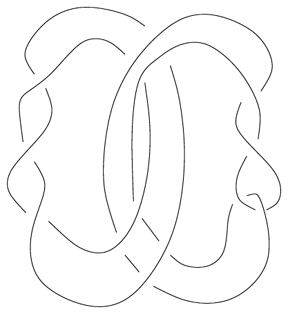Jones unknotting conjecture
Every non-trivial knot has a non-trivial Jones polynomial.

Figure: j130050a
The conjecture has been confirmed for several families of knots, including alternating and adequate knots, knots up to $18$ crossings and $2$-algebraic knots (cf. Knot theory) up to $21$ crossings [a5], [a7]. Recently (2001), S. Yamada announced that the conjecture holds for knots with up to $20$ crossings. The analogous conjecture for links does not hold, as M.B. Thistlethwaite found a $15$-crossing link whose Jones polynomial coincides with a trivial link of two components, cf. Fig.a1. This and similar examples constructed since are $2$-satellites on a Hopf link [a6], [a1].
L.H. Kauffman showed that there are non-trivial virtual knots with Jones polynomial equal to $1$, [a4].
It is still an open problem (as of 2001) whether a simple (non-satellite) link can have a Jones polynomial of an unlink.
References
| [a1] | S. Eliahou, L.H. Kauffman, M. Thistlethwaite, "Infinite families of links with trivial Jones polynomial" preprint (2001) |
| [a2] | V.F.R. Jones, "Hecke algebra representations of braid groups and link polynomials" Ann. of Math. , 126 : 2 (1987) pp. 335–388 |
| [a3] | V.F.R. Jones, "Ten problems" , Mathematics: Frontiers and Perspectives , Amer. Math. Soc. (2000) pp. 79–91 |
| [a4] | L.H. Kauffman, "A survey of virtual knot theory" , Knots in Hellas '98 , Ser. on Knots and Everything , 24 (2000) pp. 143–202 |
| [a5] | W.B.R. Lickorish, M.B. Thistlethwaite, "Some links with non-trivial polynomials and their crossing-numbers" Comment. Math. Helv. , 63 (1988) pp. 527–539 |
| [a6] | M.B. Thistlethwaite, "Links with trivial Jones polynomial" J. Knot Th. Ramifications , 10 : 4 (2001) pp. 641–643 |
| [a7] | S. Yamada, "How to find knots with unit Jones polynomials" , Knot Theory, Proc. Conf. Dedicated to Professor Kunio Murasugi for his 70th Birthday (Toronto, July 13th-17th 1999) (2000) pp. 355–361 |
Jones unknotting conjecture. Encyclopedia of Mathematics. URL: http://encyclopediaofmath.org/index.php?title=Jones_unknotting_conjecture&oldid=55687